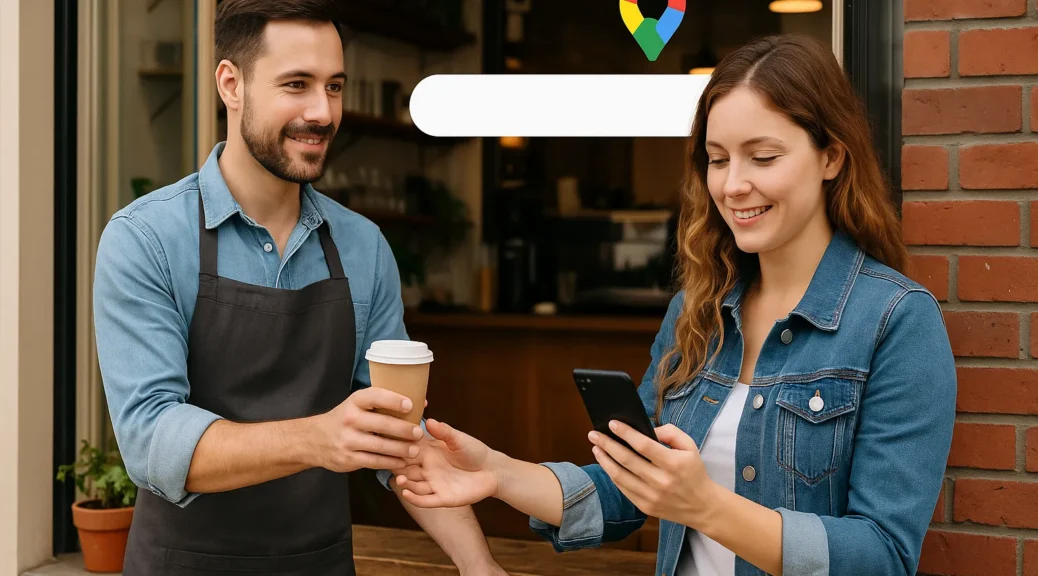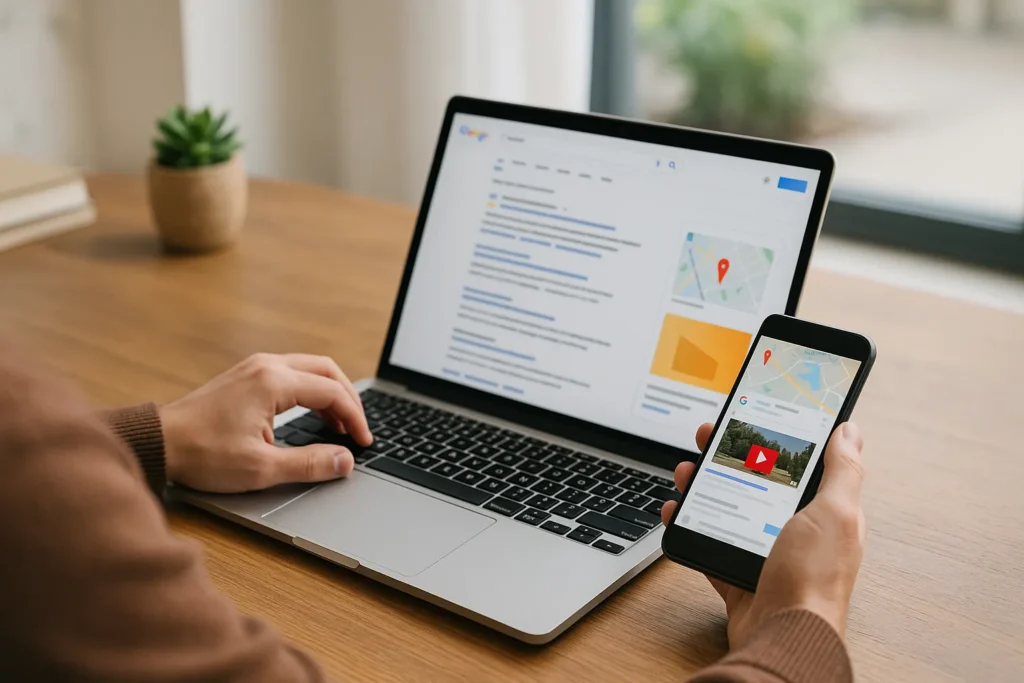
How to Use Google Ads to Generate Local Leads for Small Businesses
Are you a local business looking to generate more leads with Google Ads? You’re in luck. Our local Google Ad experts are going to share their top tips and insider strategies for dominating search results in your local area.
Local ads can easily 2-3x your business, but only if you do it right. Do it wrong, and you risk wasting thousands of dollars on ads that don’t convert or reach the wrong audience.
No worries, we’re going to show you exactly what to do. In this article, we will walk through how to set up location targeting, ads, budgets, and tracking. Then, we’ll prepare your campaigns for local foot traffic or calls, just like turning on a visibility switch.
So, fasten your seat belts. You’re about to learn everything you need to know about Google Ads.
The Fundamentals of Google Ads
Before we dive into today’s topic, we first need to understand the mechanisms that measure success. Tracking your progress is the ONLY way for you to know which clicks are bringing in the calls, form submissions, or store visits. Without it, you will be guessing, and guesses cost money.
The first step is to define your goals. What is it that you want? More phone calls? More appointment bookings? Or more foot traffic? Even when making life changing decisions, it is important to define your goals.
These goals will guide your every choice in your campaigns. Once that is cleared up, set up conversion tracking in GA4, so every valuable action is recorded.
Similar to our social media accounts, syncing your Google Ads account with GA4 and your Google Business Profile can make things simpler. With all your accounts connected, your ads will display location, details, hours, and reviews. In our experience, this makes your Ads more trustworthy in the reader’s eyes and improves your conversions.
Plus, the shared data helps you refine targeting and improve return on spend.
With this foundation in place, we can now move on to choosing the right campaign types for your business.
Choosing the Best Google Ads Campaign Types for Local Wins
There are 5 types of Google Ads campaigns: Search Campaigns, Performance Max Campaigns, Display Campaigns, Video Campaigns, and Local Services Ads. Let’s take a look at them in detail.

- Search Campaigns: A type of Google Ad campaign that targets people already looking for your product or service. The Text Ads show up on Google Search results and are highly effective for direct lead generation.
- Performance Max Campaigns: With the help of Google’s automation, Ads pop up across search, display, YouTube, Gmail, and Maps. This approach works well when you want to cover multiple channels without running separate campaigns.
- Display Campaigns: Image-based Ads that appear on websites and Apps within Google’s Display Network. If you want to build awareness, display campaigns should get the job done.
- Video Campaigns: Unlike the other Ads, this one appears on YouTube and it explains your offer or builds familiarity to the audience before they even search for you.
- Local Services Ads: The most common Google Ads of them all. It places you at the top of Google for service-based searches and charges per lead, not per click.
Before you choose the right Google Ad campaign for your business, we suggest you first understand your needs clearly. We recommend you get help from a service provider with experience in your niche. With help, planning and choosing the right campaign becomes easier.
Next, we’ll focus on location targeting strategies that bring in nearby customers.
Location Targeting Secrets That Keep Your Ads Local
After choosing the campaign type that fits your goals, the next move is fine-tuning location settings to match. This step connects your ad strategy to the people who can actually buy from you, helping you spend where it matters most.
Our number one tip is to target people within a practical service area. This makes your budget work harder by reaching those who are most likely to become customers.
Presence Targeting vs. Interest Targeting
Presence targeting shows ads only to people physically within your chosen area. Many local service providers choose this method because it reduces wasted clicks from users too far away to convert (I personally preferred this one too when I had just started my business).
On the other hand, interest targeting reaches people outside your area who have searched for or shown interest in a particular thing. This option works well for tourism, events, or destination-based services.
Setting an Effective Service Radius
Targeting an entire city can drain your budget quickly. Instead, draw a digital circle around your address to focus on the areas most likely to bring customers.
Your ideal radius depends on what type of business you are.
For cafés, gyms, and salons, a smaller radius of 1–5 miles often delivers better results, while tradespeople or delivery services may benefit from covering a wider area. Another good example would be restaurants.
They’d want to target something like 10-15 miles out, since people will often drive longer distances for popular food spots.
It is vital you review your performance data regularly and adjust the radius accordingly. It will ensure that your spend isn’t going to waste.
Exclude To Protect Your Budget
Another exclusive tip for you is location exclusions. Sounds complex but it’s really not. Location exclusions help cut out areas that rarely convert, ensuring your money is spent where it has the most impact. For instance, it could mean removing:
- High-traffic zones such as airports
- Postcodes with low conversion rates
- Suburbs that are too far for customers to travel from
Here is a suggestion, review and update your exclusions each month, it will keep your targeting accurate. Once your targeting is set, the next step is choosing local keywords that match what people search for when they need your services
Local-Intent Keywords That Convert Clicks Into Customers
With your targeting in place, it’s time to choose keywords that connect your ads with people ready to act. Local-intent keywords focus your budget on searchers who want your service, not just general information.

Here is what I mean. Lazy people like myself usually end up searching for terms like “plumber near me” or “bakery in Brooklyn”. So, think about using similar keywording phrases that show clear intent and location. Businesses often call this the golden method of attracting high-quality leads (within their vicinity).
BUT you cannot forget to use negative keywords. It is the only way for you to block irrelevant searches. Doing this will save your budget for clicks for real customers.
I hope we are clear on how and why keyword phrasing is important.
Moving on…
Writing Click-Worthy Ads That Feel Local
Local ads work best when they speak to the community. Here is what you can do! Mention landmarks, neighborhoods, or events in your Ad copy. After all, familiarity builds trust with potential customers (I would definitely check out a new cafe opening close to my favorite bookstore).
If I haven’t emphasized it enough, then here it is again, strong headlines hold good weight. You can start by combining your service, location, and mention a clear benefit to make your ads stand out. Here is an example I saw the other day, “Fresh Bread Daily in Austin.” Believe me when I say I had to check out that bread.
Just like that when you have convincing headlines, people are bound to click.
You can make your ads even more effective with ad extensions:
- Location extensions show your business address.
- Call extensions let people reach you instantly.
- Sitelinks guide visitors to specific pages on your site.
Using the right mix of extensions adds action to your ads and can improve click-through rates.
Next, we’ll look at how to choose Ad assets that drive even more engagement.
Boost Performance With Ad Assets That Drive Action
Your Ad copy is ready to go. The next step is adding extras that people can see before they even click. These ad assets make your ads stand out even more in search results. There are some commonly used Ad assets that we think you should know about:
- Lead form assets: It allows people to send you their details directly from the search results.
- Image assets: Popularly known for adding visual appeal and explaining your offer quickly.
- Review assets: This one highlights positive feedback to build trust.
- Price assets: Your rates are displayed so customers can compare at a glance.
When you combine these with location, call, and sitelink extensions, your ads can get more clicks and leads without costing more. They also make it easier for people to take the next step.
Now let’s make your landing page match your ads and turn visitors into customers.
Make Your Landing Page a Local Lead Magnet
Getting a click is only half the job.
The page your Ad sends people to must turn their interest into action. If your landing page does not deliver on what the Ad promised, you risk losing the lead.
So, start by making your contacts impossible to miss. You can use a clear phone button, enquiry form, or “Book Now” link and ensure that it is visible without scrolling. Also, add a map and your address so people know you serve their area.
Speed matters, too. A page that loads in under three seconds keeps visitors from leaving before they see your offer. That’s why we suggest keeping the design clean, mobile-friendly, and focused on one main call-to-action.
With your landing page ready to convert, we can now focus on tracking performance so you know exactly which clicks are worth your spend.
The Importance of Tracking Results
We have covered running Ads. But real growth comes from knowing what happens after someone clicks and using that insight to improve results.
Connecting Google Ads with Google Analytics gives you a clear view of visitor behavior. You can see the pages they view, how long they stay, and where they leave. This helps you spot what’s attracting leads and what’s driving them away.

Once you understand that behavior, check your key metrics in Google Ads:
- Click-through rate (CTR): Shows if your ad is grabbing attention.
- Conversion rate: Measures how many visitors take action.
- Cost per conversion: Tracks how efficiently you’re spending.
Reviewing this data regularly makes it easier to decide when to adjust keywords, update ad copy, or move budget. Small changes can often improve results without increasing spend.
Is it all too much? How about hiring an expert team to handle every detail? It is the best way to get it all done without guesswork.
Let Evoasis Build Your Local Lead Machine
Running effective Google Ads for local businesses is not a piece of cake. It is time, testing, and constant fine-tuning.
No worries! Evoasis can handle it all for you. From targeting the right customers to writing ads that feel personal and local to your audience.
Our team creates affordable, custom strategies built to bring in real leads, not just clicks.
So, do you want more local customers without the trial-and-error phase? Then, reach out to Evoasis today. Get your local presence blooming with confidence!